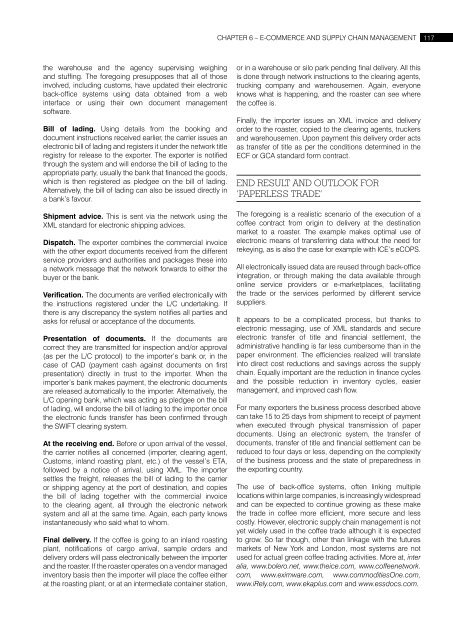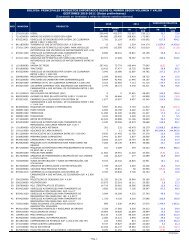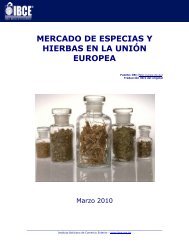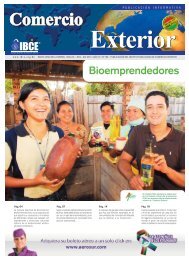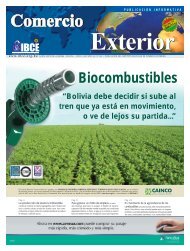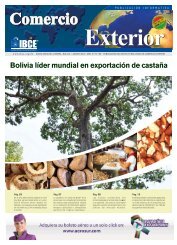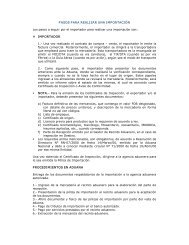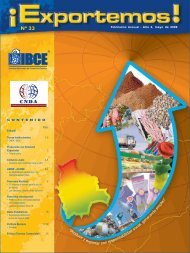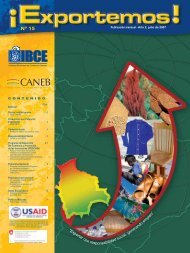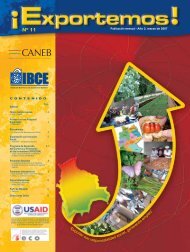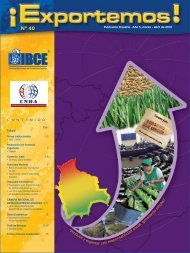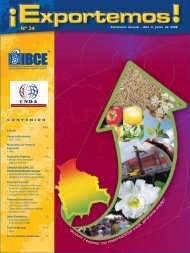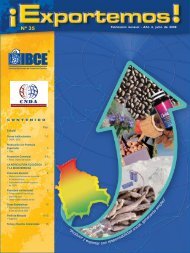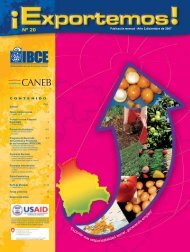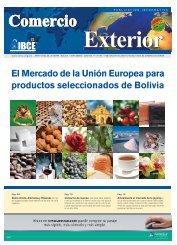The Coffee Exporter's Guide - International Trade Centre
The Coffee Exporter's Guide - International Trade Centre
The Coffee Exporter's Guide - International Trade Centre
- TAGS
- www.ibce.org.bo
Create successful ePaper yourself
Turn your PDF publications into a flip-book with our unique Google optimized e-Paper software.
the warehouse and the agency supervising weighing<br />
and stuffi ng. <strong>The</strong> foregoing presupposes that all of those<br />
involved, including customs, have updated their electronic<br />
back-offi ce systems using data obtained from a web<br />
interface or using their own document management<br />
software.<br />
Bill of lading. Using details from the booking and<br />
document instructions received earlier, the carrier issues an<br />
electronic bill of lading and registers it under the network title<br />
registry for release to the exporter. <strong>The</strong> exporter is notifi ed<br />
through the system and will endorse the bill of lading to the<br />
appropriate party, usually the bank that fi nanced the goods,<br />
which is then registered as pledgee on the bill of lading.<br />
Alternatively, the bill of lading can also be issued directly in<br />
a bank’s favour.<br />
Shipment advice. This is sent via the network using the<br />
XML standard for electronic shipping advices.<br />
Dispatch. <strong>The</strong> exporter combines the commercial invoice<br />
with the other export documents received from the different<br />
service providers and authorities and packages these into<br />
a network message that the network forwards to either the<br />
buyer or the bank.<br />
Verifi cation. <strong>The</strong> documents are verifi ed electronically with<br />
the instructions registered under the L/C undertaking. If<br />
there is any discrepancy the system notifi es all parties and<br />
asks for refusal or acceptance of the documents.<br />
Presentation of documents. If the documents are<br />
correct they are transmitted for inspection and/or approval<br />
(as per the L/C protocol) to the importer’s bank or, in the<br />
case of CAD (payment cash against documents on fi rst<br />
presentation) directly in trust to the importer. When the<br />
importer’s bank makes payment, the electronic documents<br />
are released automatically to the importer. Alternatively, the<br />
L/C opening bank, which was acting as pledgee on the bill<br />
of lading, will endorse the bill of lading to the importer once<br />
the electronic funds transfer has been confi rmed through<br />
the SWIFT clearing system.<br />
At the receiving end. Before or upon arrival of the vessel,<br />
the carrier notifi es all concerned (importer, clearing agent,<br />
Customs, inland roasting plant, etc.) of the vessel’s ETA,<br />
followed by a notice of arrival, using XML. <strong>The</strong> importer<br />
settles the freight, releases the bill of lading to the carrier<br />
or shipping agency at the port of destination, and copies<br />
the bill of lading together with the commercial invoice<br />
to the clearing agent, all through the electronic network<br />
system and all at the same time. Again, each party knows<br />
instantaneously who said what to whom.<br />
Final delivery. If the coffee is going to an inland roasting<br />
plant, notifi cations of cargo arrival, sample orders and<br />
delivery orders will pass electronically between the importer<br />
and the roaster. If the roaster operates on a vendor managed<br />
inventory basis then the importer will place the coffee either<br />
at the roasting plant, or at an intermediate container station,<br />
CHAPTER 6 – E-COMMERCE AND SUPPLY CHAIN MANAGEMENT 117<br />
or in a warehouse or silo park pending fi nal delivery. All this<br />
is done through network instructions to the clearing agents,<br />
trucking company and warehousemen. Again, everyone<br />
knows what is happening, and the roaster can see where<br />
the coffee is.<br />
Finally, the importer issues an XML invoice and delivery<br />
order to the roaster, copied to the clearing agents, truckers<br />
and warehousemen. Upon payment this delivery order acts<br />
as transfer of title as per the conditions determined in the<br />
ECF or GCA standard form contract.<br />
END RESULT AND OUTLOOK FOR<br />
‘PAPERLESS TRADE’<br />
<strong>The</strong> foregoing is a realistic scenario of the execution of a<br />
coffee contract from origin to delivery at the destination<br />
market to a roaster. <strong>The</strong> example makes optimal use of<br />
electronic means of transferring data without the need for<br />
rekeying, as is also the case for example with ICE’s eCOPS.<br />
All electronically issued data are reused through back-offi ce<br />
integration, or through making the data available through<br />
online service providers or e-marketplaces, facilitating<br />
the trade or the services performed by different service<br />
suppliers.<br />
It appears to be a complicated process, but thanks to<br />
electronic messaging, use of XML standards and secure<br />
electronic transfer of title and fi nancial settlement, the<br />
administrative handling is far less cumbersome than in the<br />
paper environment. <strong>The</strong> effi ciencies realized will translate<br />
into direct cost reductions and savings across the supply<br />
chain. Equally important are the reduction in fi nance cycles<br />
and the possible reduction in inventory cycles, easier<br />
management, and improved cash fl ow.<br />
For many exporters the business process described above<br />
can take 15 to 25 days from shipment to receipt of payment<br />
when executed through physical transmission of paper<br />
documents. Using an electronic system, the transfer of<br />
documents, transfer of title and fi nancial settlement can be<br />
reduced to four days or less, depending on the complexity<br />
of the business process and the state of preparedness in<br />
the exporting country.<br />
<strong>The</strong> use of back-offi ce systems, often linking multiple<br />
locations within large companies, is increasingly widespread<br />
and can be expected to continue growing as these make<br />
the trade in coffee more effi cient, more secure and less<br />
costly. However, electronic supply chain management is not<br />
yet widely used in the coffee trade although it is expected<br />
to grow. So far though, other than linkage with the futures<br />
markets of New York and London, most systems are not<br />
used for actual green coffee trading activities. More at, inter<br />
alia, www.bolero.net, www.theice.com, www.coffeenetwork.<br />
com, www.eximware.com, www.commoditiesOne.com,<br />
www.iRely.com, www.ekaplus.com and www.essdocs.com.


